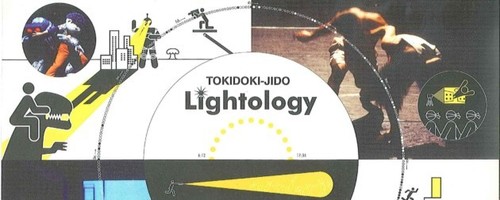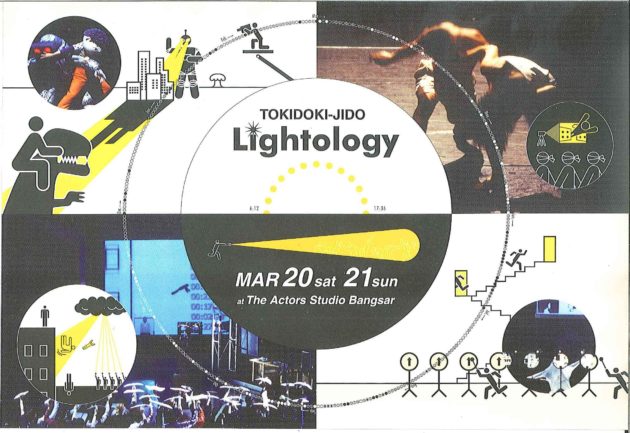March 20 (Sat) at 15:00 and 20:30
March 21 (Sun) at 15:00
@The Actors Studio Bangsar
Adult- RM 35 Students and JFKL members – RM 15
*There will be a 20 minute interaction between the audience and performers after the show
Invitation to volunteers for TOKIDOKI-JIDO performance! [Registration Closed]
Tokidoki-Jido is inviting 50 volunteers to participate in their performance in the areas of video camera operation, dance, stage prop-manipulation, back-up voice performance and etc. This workshop will be conducted for 3 days.
Workshop Schedule
15 -17 March 2004 > 6pm -9pm
19 March 2004 > 6pm onwards (Final Rehearsal)
>@ *Bilik Kenaga, 1st Floor, Jabatan Kebudayaan dan Kesenian Wilayah Persekutuan
109 Jalan Ampang (Besides Saloma Restaurant at Malaysia Tourism Centre)
Participants will then be ready for the three performances on March 20 (3.00pm & 8.30pm) and March 21 (3.00pm).
>What’s TOKIDOKI-JIDO ?
TOKIDOKI-JIDO (means “sometimes automatic”) is a theatrical group established in 1985, and one of the pioneers of Performance Theater in Japan. In the works of TOKIDOKI-JIDO, music, audiovisuals, dance, art and poem are blended together and function as its original language. That is completely a new type of Action Art. The theme of performance is to search for dynamic programs that could change our sorrow and despair into pleasure and hope.
We believe there are still undiscovered possibilities in music, dance, audiovisuals, art and words. To discover them one by one and to make good use of them as a new language for telling hope, those are the originality of TOKIDOKI-JIDO.
The works of TOKIDOKI-JIDO have always been and it will be encouraging audience and show them the way toward “hope.” Therefore we have been working on physical and academic research constantly, and we often give workshops to share our idea with people.
Supported by The Japan Foundation and Commemorative Association for the Japan World Exposition
>Music
Original experimental music is created with instruments, computer, voice and etc. Not only ready-made instruments, but also hand-made ones are also used and even a coffee machine or a microwave could be an instrument for our music.
>Word
There is no coherent story, but only fragments. As if the fragments of story diffusely reflect and develop by reticent “words” and contained performance, can rouse people’s imagination. TOKIDOKI-JIDO creates the world before the story comes into existence.
>Dance
We have created original dance system by observing body movement and function of body joints. Our original dance is called ‘Kuu-Jami’. Performers dance systematically with many rhythm patterns memorized in their mind.
>Stage set and props
Many objects and decors appear on the stage giving various images to audience as well as performers movement. They could be rather individual art works than merely stage decor.
>Audiovisuals
Various media such as video, film, animation, and slide projection are used on the stage. And they are handled and appeared in the style of TOKIDOKI-JIDO.
>What’s ‘Lightology’?
The theme is about ‘light’ and it shows the conflict between human’s despair and hope. The premiere was in Tokyo, 2002. Many people appreciated it as a true contemporary art piece with the organic linkage of music, dance, audiovisuals and words. For premiere, we created various scenes together with many volunteer performers. The word “Lightology” was originally named by the director Naoyuki Asahina, with the meaning of “to think about light (= hope).”
>”Idea of volunteer performers”
Since “Thinking of TOKIDOKI-JIDO”(1999), we have made performance pieces with more than 100 volunteer performers. This was to embody our idea that art should be created by working with public and should not be possessed only by artists. This process of process of production is based on our idea of trying to find the possibility of theatre by communicating with society directly.
We created various scenes together with many volunteer performers, most of them were people in general, in order to give much more powerful reality in the performances. According to this principle, we would cordially invite people in Malaysia to participate in our creative works. We expect to bring new possibility for theater in Malaysia and it could be the real exchange of ideas between the two countries.
(Example of volunteer performers’ works are: video camera operation, dance, decor manipulation, voice performance, etc.)
>“Selected Stage Works”
Oct. 1988 “ICHINICHI (one day long)” in Tokyo / Participated in the “2nd Aoyama Theater Festival”
Nov. 1989 “KINEN (commemoration)” in Tokyo, Osaka, Nagoya
Oct. 1990 “CONVENTION II.v” in Tokyo, Osaka, Nagoya, Kushiro, Sapporo, Kanazawa, Kobe, Fuji)
Nov. 1990 “TABISHITA (traveled)” in Tokyo
Nov. 1991 “IEOTATERU (building a house)” in Tokyo, Nagoya
Oct. 1992 “15min.” “1day??29000days” in Berlin, Hebbel Theater/ Participated in the 8th Urbane Aboriginal Festival
Dec. 1992 “TABISHITA Berlin version” in Tokyo
Sep. 1994 “M?m” in Tokyo, Nagoya
Oct. 1995 “M?m” in Munich, Muffathalle / Participated in “SPIEL.ART” Theater festival in Munich
Dec. 1995 “TABISHITA Munich version” in Tokyo
Oct. 1996 “GO BY AIRPLANE ” in Tokyo
Mar. 1999 “THINKING OF TOKIDOKI-JIDO ” in Tokyo
Jan.-Nov. 2000 “6events” in Tokyo
Mar. 2002 “Lightology” in Tokyo
Mar. 2003 “katachi no katachi (figure for figure) ” in Tokyo
Nov. 2003 “dance no dance (dance for dance)” in Tokyo
>“Critiques”
-Via their unique use of technology and the cast of young actresses/singers/musicians, Tokidoki-Jido presents a series of evocative visuals, sounds, and movements. And through their avoidance of logical time sequences they’ve been able to explore new concepts of performance. To seasoned theater buffs expecting any sort of dramatic development, this might all be incomprehensible. For children, as well as adults who still possess the childlike ability to accept alternative realities, however, this is a wondrous new world.
THE JAPAN TIMES, Oct.08, 1994 / MIKI MIYATAKE)
-How can one summarize what does not belong together? How can one tell what makes one speechless? Surprising is the ease with which the director Asahina Naoyuki combines and reshapes dance, music, theater, mimic, video, film, song, and art works. Drums become projection screens, clothes become instruments, and instruments become sculptures and sculptures become actors. Words, images and sounds merge into a new stage language.
Suddeutsche Zeitung, Oct.16, 1995 / Karin Steinberger
-Since its start in 1985, the activity of TOKIDOKI-JIDO has been eroding and digesting the existing category with sloughing and transforming itself. Performers of TOKIDOKI-JIDO, moving around on the stage, sometimes dance, sometimes play instruments, and sometimes play roles. Not by dividing works, they dare to show theatrical aspects in music and to draw dance from the dynamism of playing instruments. They invent original ways of composing music, choreography and even make instruments. Such system brings a vividness, which never happens, from collaboration or a compromising work of each field’s specialist.
Not “always automatic” but “sometimes automatic”. Our body that moves with habits exists also in such a semi-automatic way. The body might be provisional formed with organs, which were applied variously in the evolution process. A scholar called it the bricolage on evolution. That is to assemble new appliances and machines by well combining existing materials. TOKIDOKI-JIDO also transforms performers, projectors, and sequencers into a new stage by the same approach.
By regarding a theater space as a performance machine, they spread their body there that is expanding to the stage. That is the work of TOKIDOKI-JIDO.
BT / Bijutsu Techo, May, 2001 / Nozomu Yanagisawa




